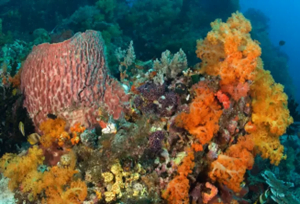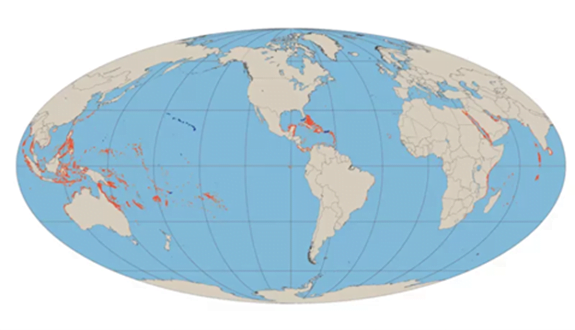Environment & Ecology
Context: Recently Scientists discovered five new species of black corals living as deep as 2,500 feet (760 meters) below the surface in the Great Barrier Reef and Coral Sea off the coast of Australia by using a remote-controlled submarine.
About black corals:

- Black corals or antipatharians are colonial animals which are related to sea anemones and stony corals.
- They are named for the colour of their stiff, black or brownish skeleton.
- More than 150 species of black corals have been described. At least 14 species of black corals are currently known from Hawai’i.
- Distribution: Black corals are found in all oceans, but are most common in deep water habitats of tropical and subtropical seas.
- Black corals are carnivores.
- Black corals can be found growing both in shallow waters and down to depths of over 26,000 feet (8,000 meters), and some individual corals can live for over 4,000 years.
- Black corals are filter feeders and eat tiny zooplankton that are abundant in deep waters.
- While colourful shallow-water corals rely on the sun and photosynthesis for energy.
About Corals:
- Coral reefs are the most diverse of all marine ecosystems. They teem with life, with perhaps one-quarter of all ocean species depending on reefs for food and shelter.
- Because they are so diverse, coral reefs are often called the rainforests of the sea.
 \
\

- Shallow water corals that live in warm water often have another source of food, the zooxanthellae (pronounced zo-o-zan-THELL-ee).
- These single-celled algae photosynthesize and pass some of the food they make from the sun’s energy to their hosts, and in exchange the coral animal gives nutrients to the algae.
- The zooxanthellae also provide much of the green, brown, and reddish colours that corals have.
Coral Diversity:
- In the so-called true stony corals, which compose most tropical reefs, each polyp sits in a cup made of calcium carbonate.
- Stony corals are the most important reef builders, but organpipe corals, precious red corals, and blue corals also have stony skeletons.
- There are also corals that use more flexible materials or tiny stiff rods to build their skeletons—the seafans and sea rods, the rubbery soft corals, and the black corals.
- The fire corals (named for their strong sting) are anthozoans, which are divided into two main groups.
- The hexacorals have smooth tentacles, often in multiples of six, and the octocorals have eight tentacles, each of which has tiny branches running along the sides. All corals are in the phylum Cnidaria, the same as jellyfish.
Reproduction:
- Corals have multiple reproductive strategies – they can be male or female or both, and can reproduce either asexually or sexually.
- Asexual reproduction is important for increasing the size of the colony, and sexual reproduction increases genetic diversity and starts new colonies that can be far from the parents.
Coral distribution across the world:
- Corals are found across the world’s ocean, in both shallow and deep water, but reef-building corals are only found in shallow tropical and subtropical waters.
- This is because the algae found in their tissues need light for photosynthesis and they prefer water temperatures between 70-85°F (22-29°C).
- There are also deep-sea corals that thrive in cold, dark water at depths of up to 20,000 feet (6,000 m).
- Both stony corals and soft corals can be found in the deep sea.
- Deep-sea corals do not have the same algae and do not need sunlight or warm water to survive, but they also grow very slowly. One place to find them is on underwater peaks called seamounts.

Australia’s Great Barrier Reef (GBR)
- The reef is located in the Coral Sea, off the coast of Queensland, Australia.
- This reef was selected as a World Heritage Site in 1981.
- A large part of the reef is protected by the Great Barrier Reef Marine Park.
Threats:
- Ocean Acidification
- Overfishing and overharvesting of corals
- coral bleaching
- Sunscreen chemicals
- Many corals are threatened by illegal harvesting for jewellery.
Source: The Hindu
Previous Year Question
Q.1) Consider the following statements:
- Asiatic lion is naturally found in India only
- Double-humped camel is naturally found in India only
- One-horned rhinoceros is naturally found in India only
Which of the statements given above is/are correct? (2019)
- 1 only
- 2 only
- 1 and 3 only
- 1, 2 and 3
Q.2) Consider the following statements:
- Some species of turtles are herbivores
- Some species of fish are herbivores.
- Some species of marine mammals are herbivores
- Some species of snakes are viviparous
Which of the statements given above are correct? (2019)
- 1 and 3 only
- 2, 3 and 4 only
- 2 and 4 only
- 1, 2, 3 and 4













